Charles E W Bean, Diaries, AWM38 3DRL 606/272/1 - 1917 - 1932 - Part 12
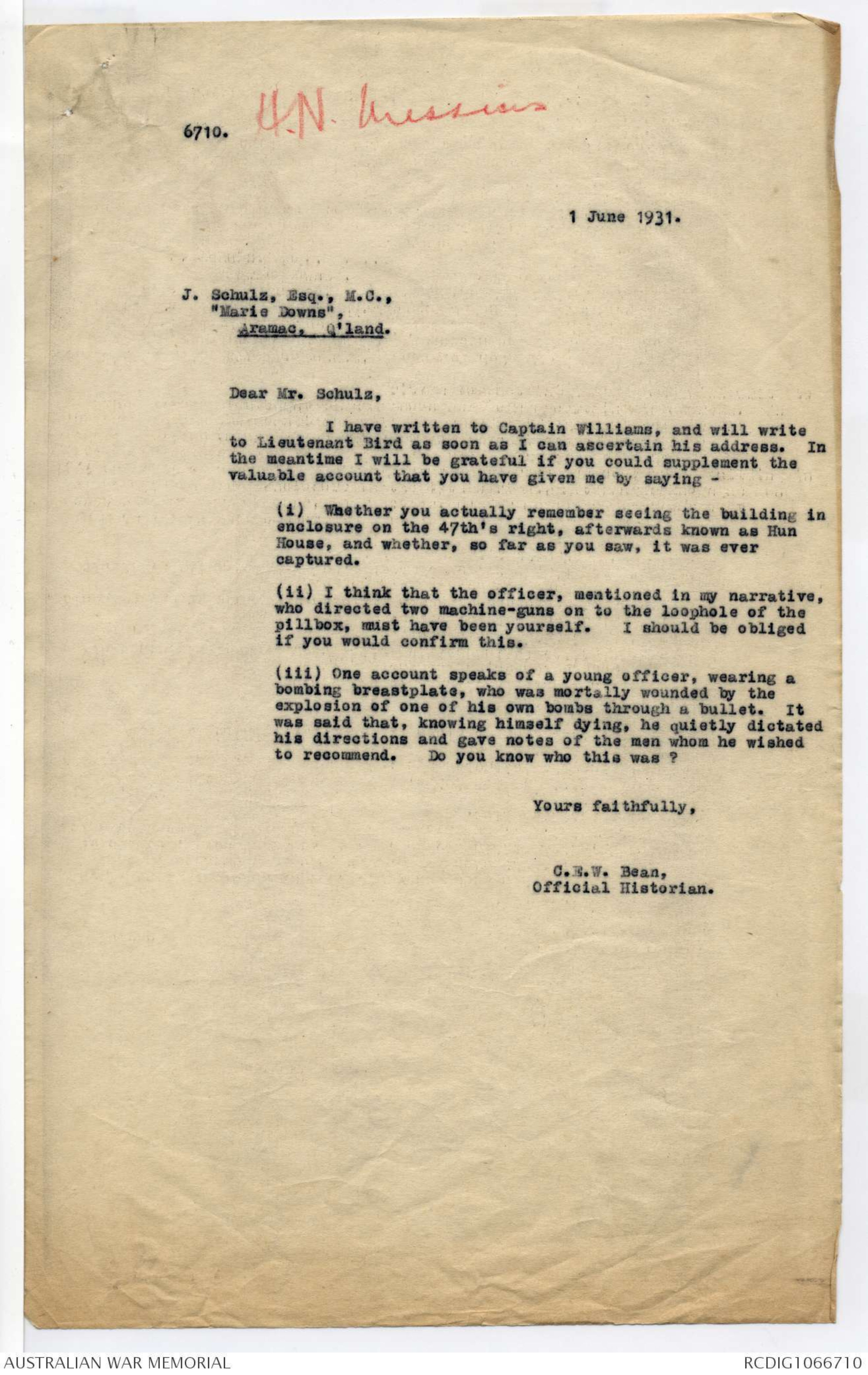
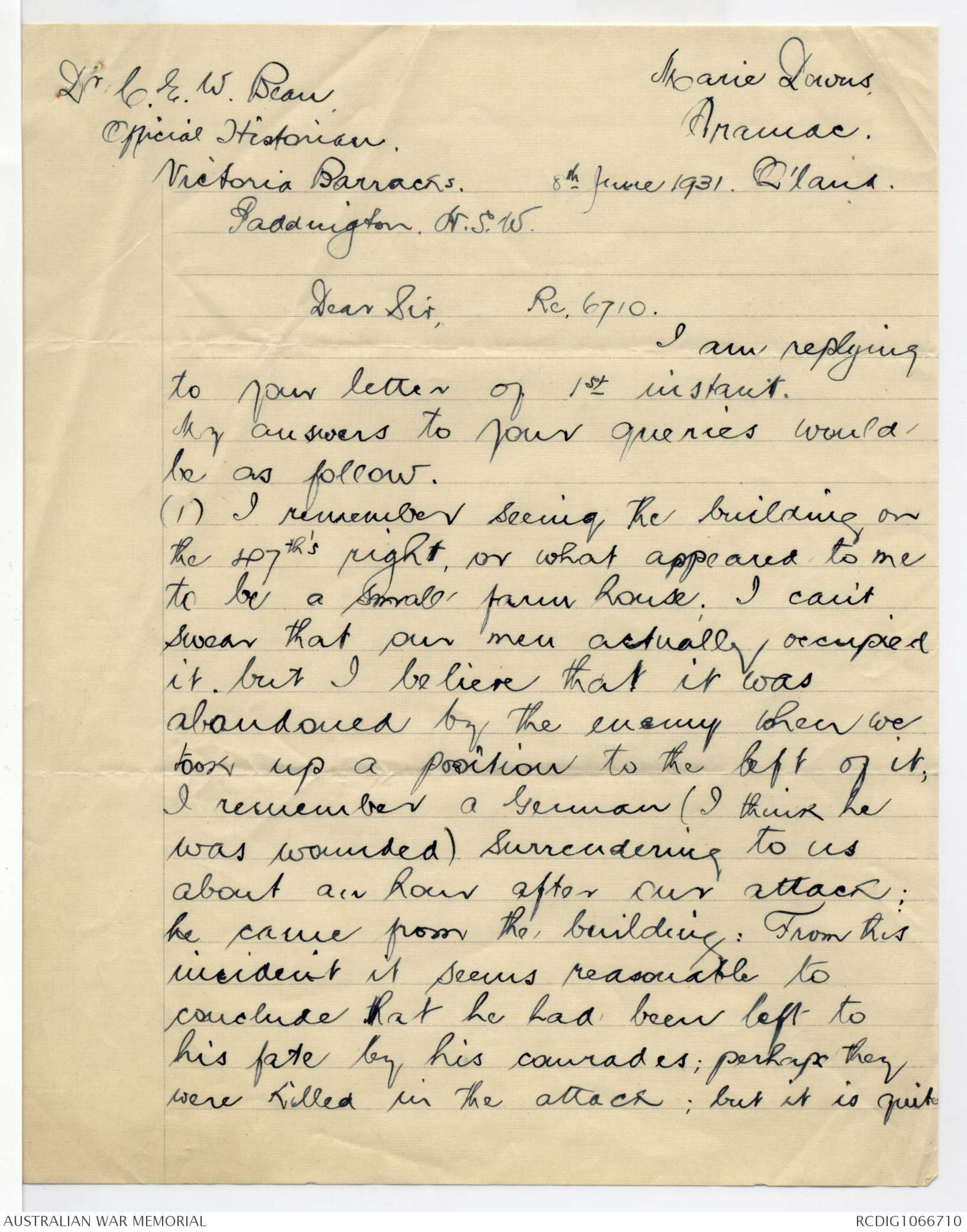
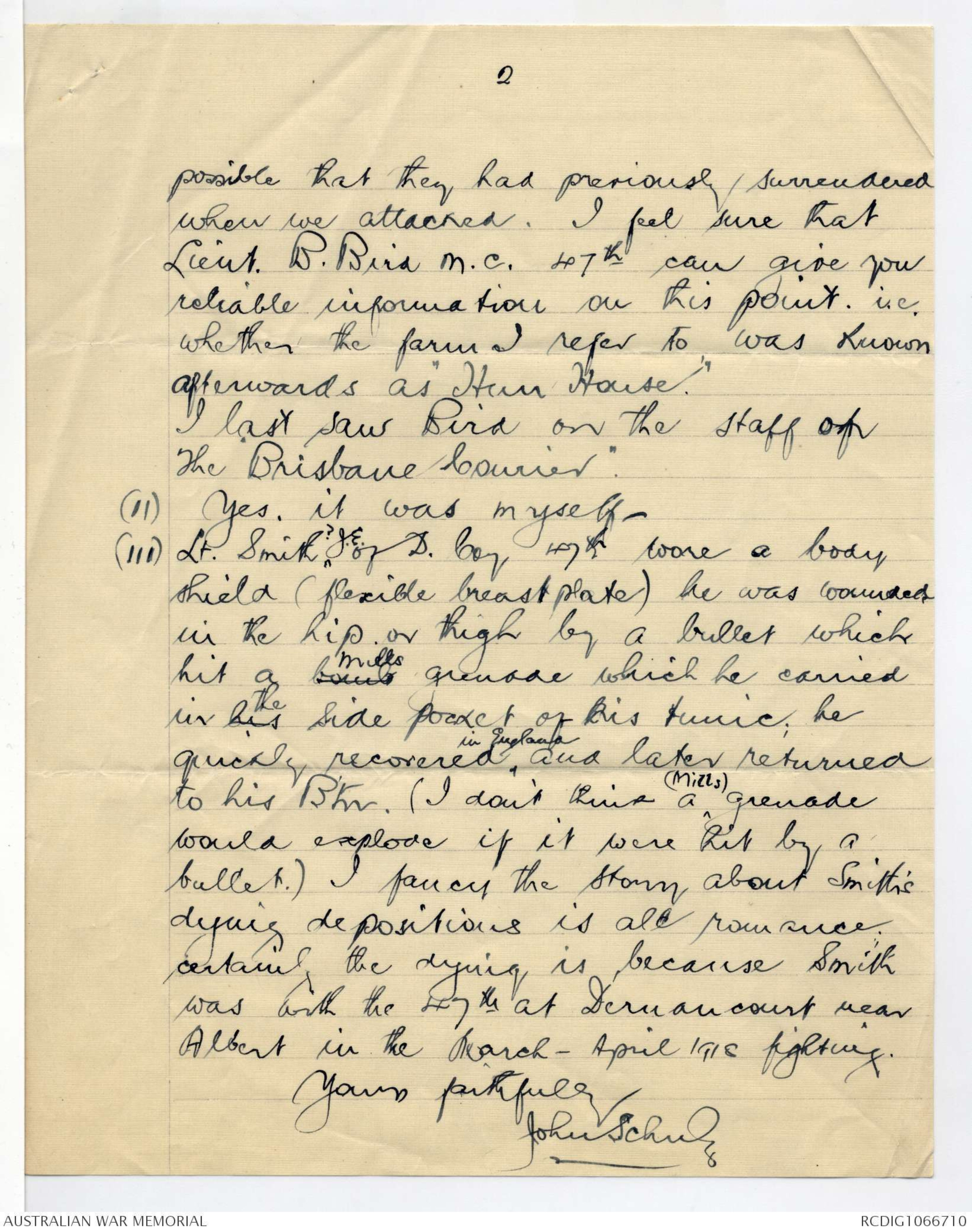
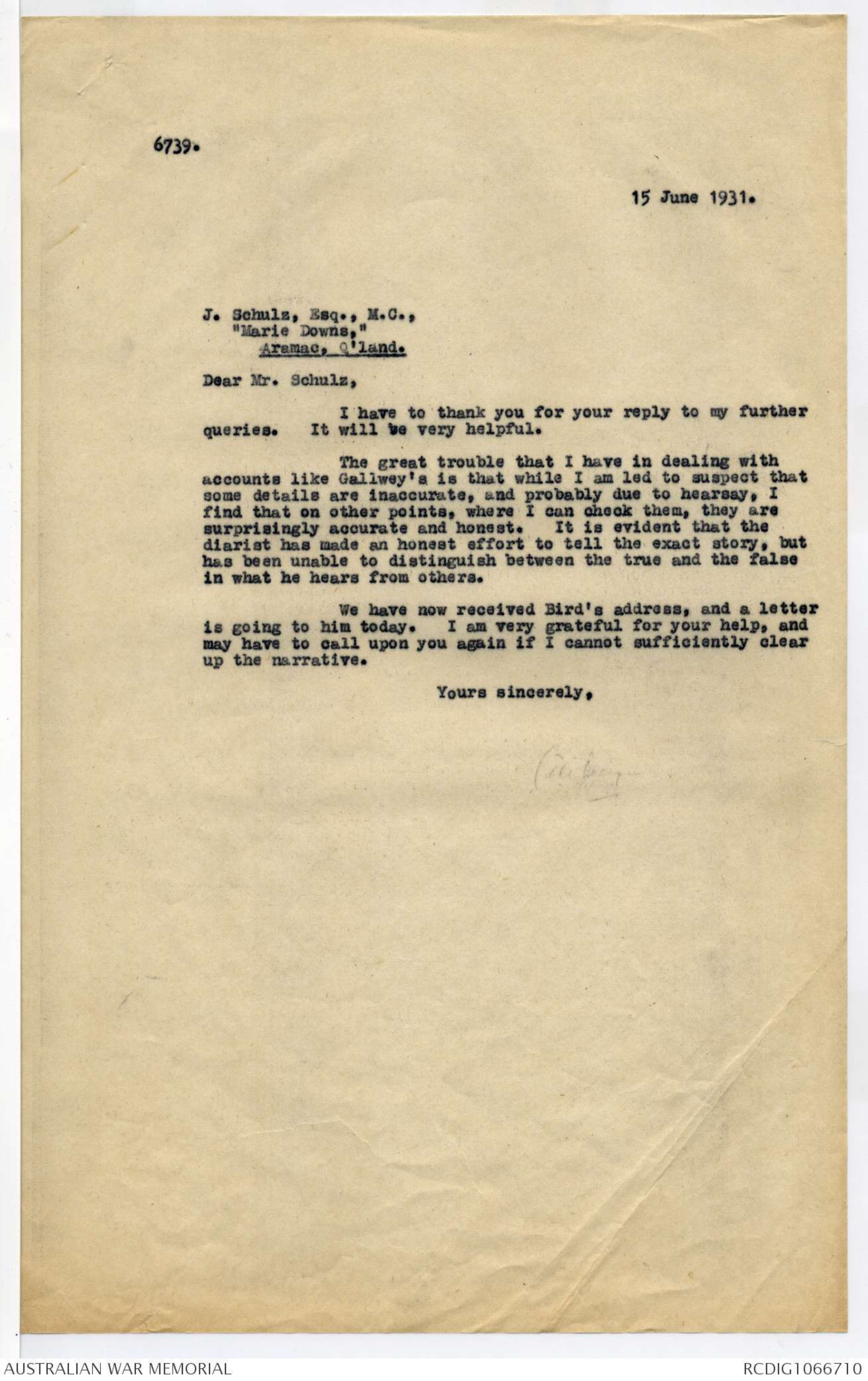
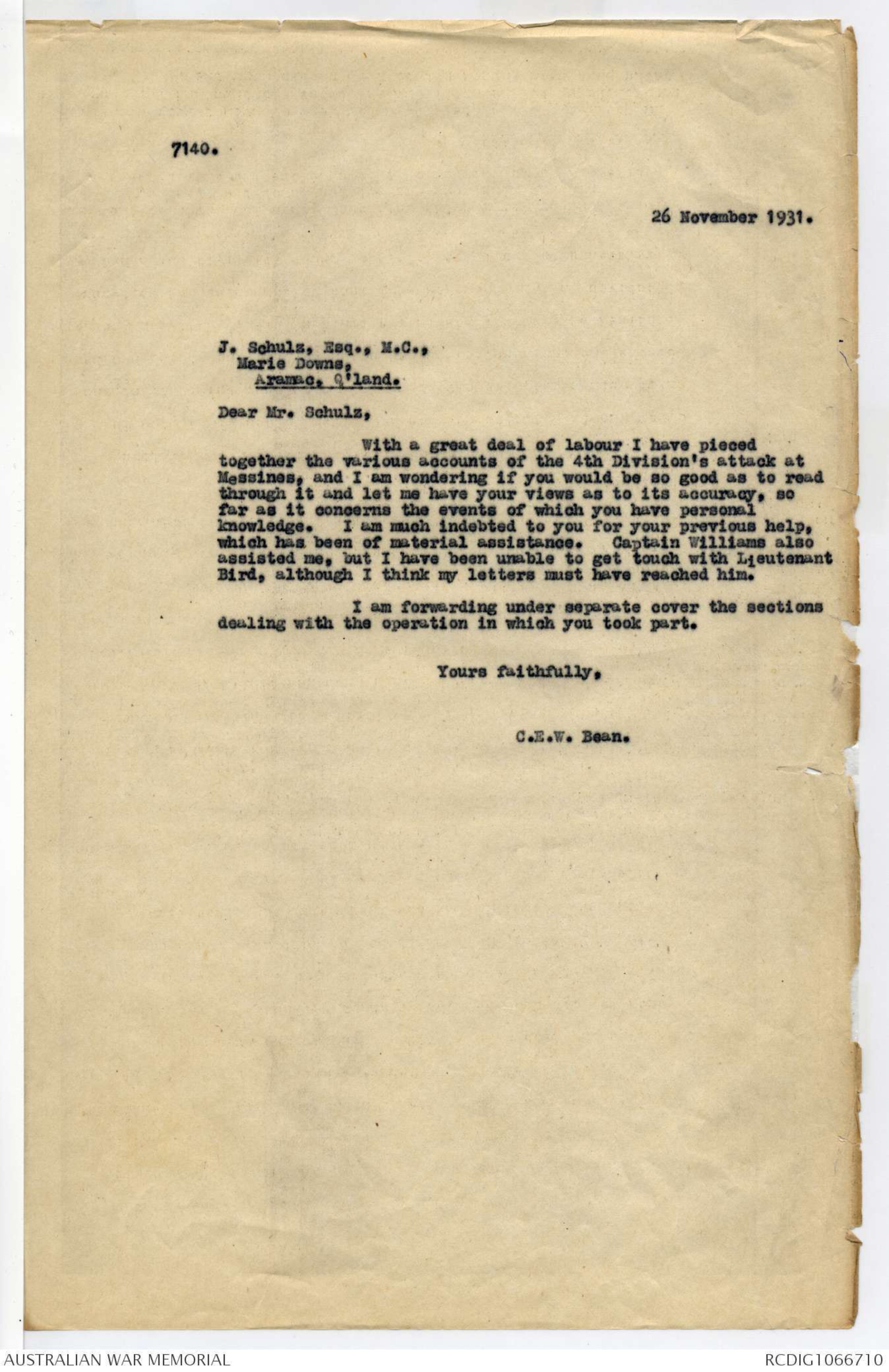
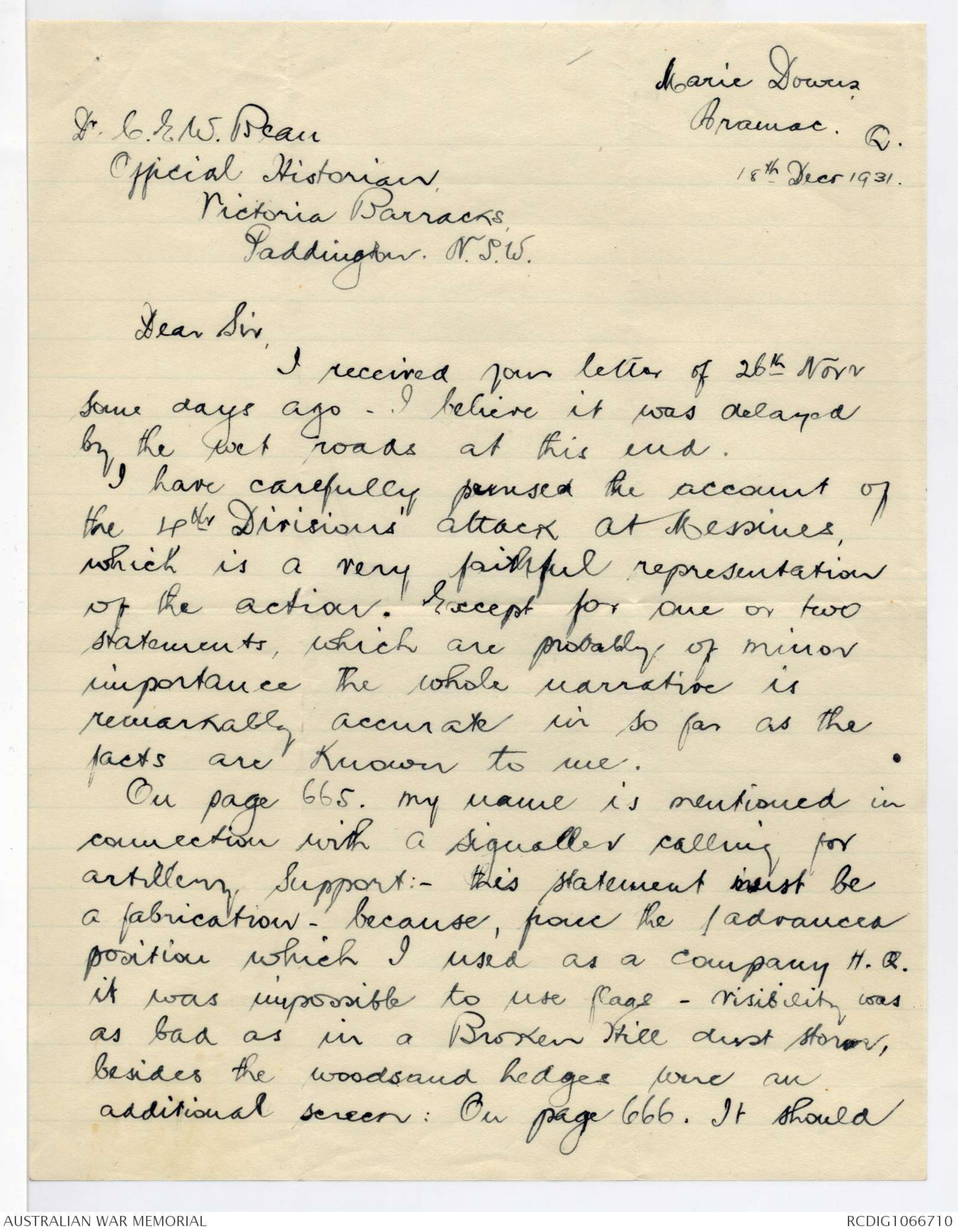
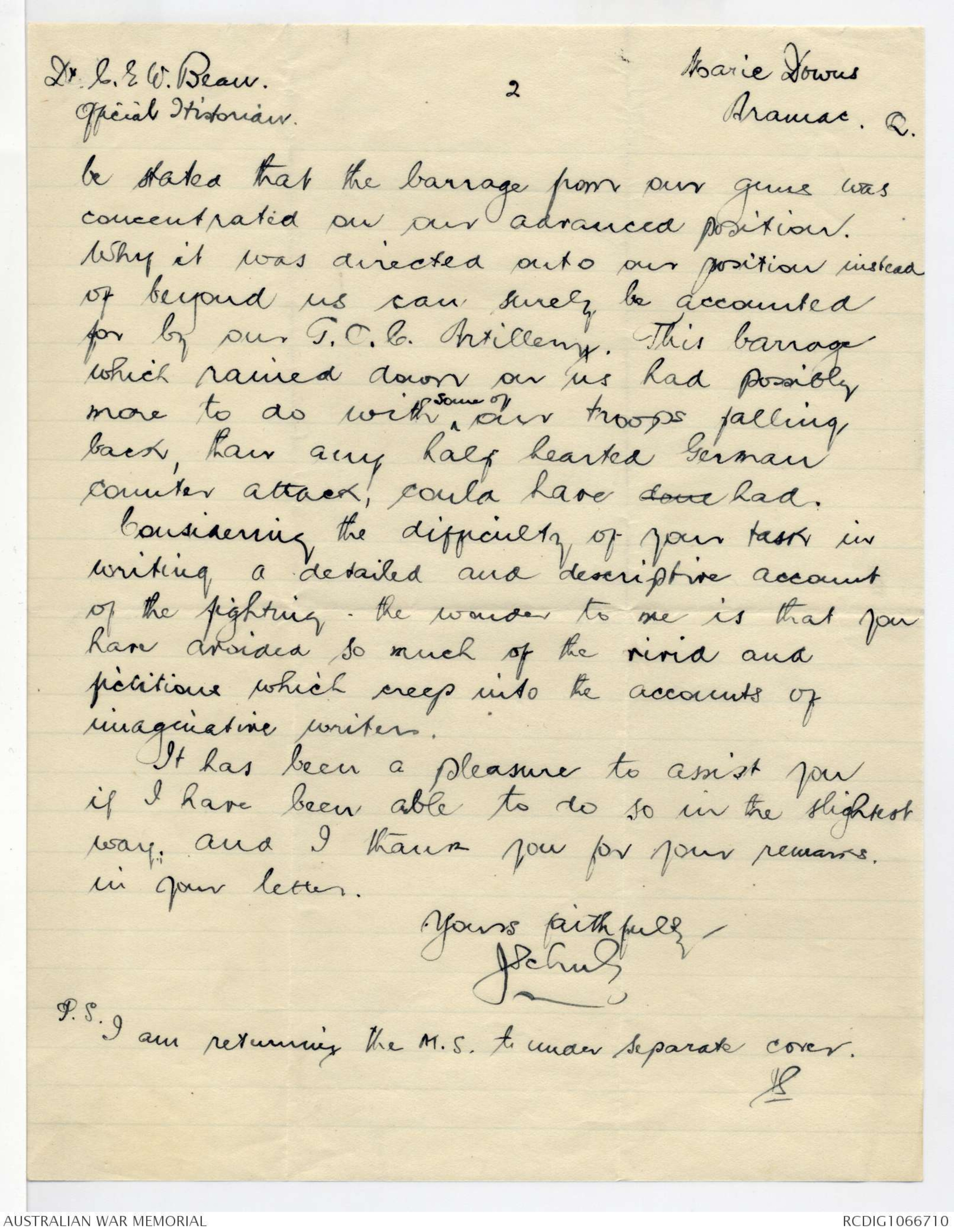
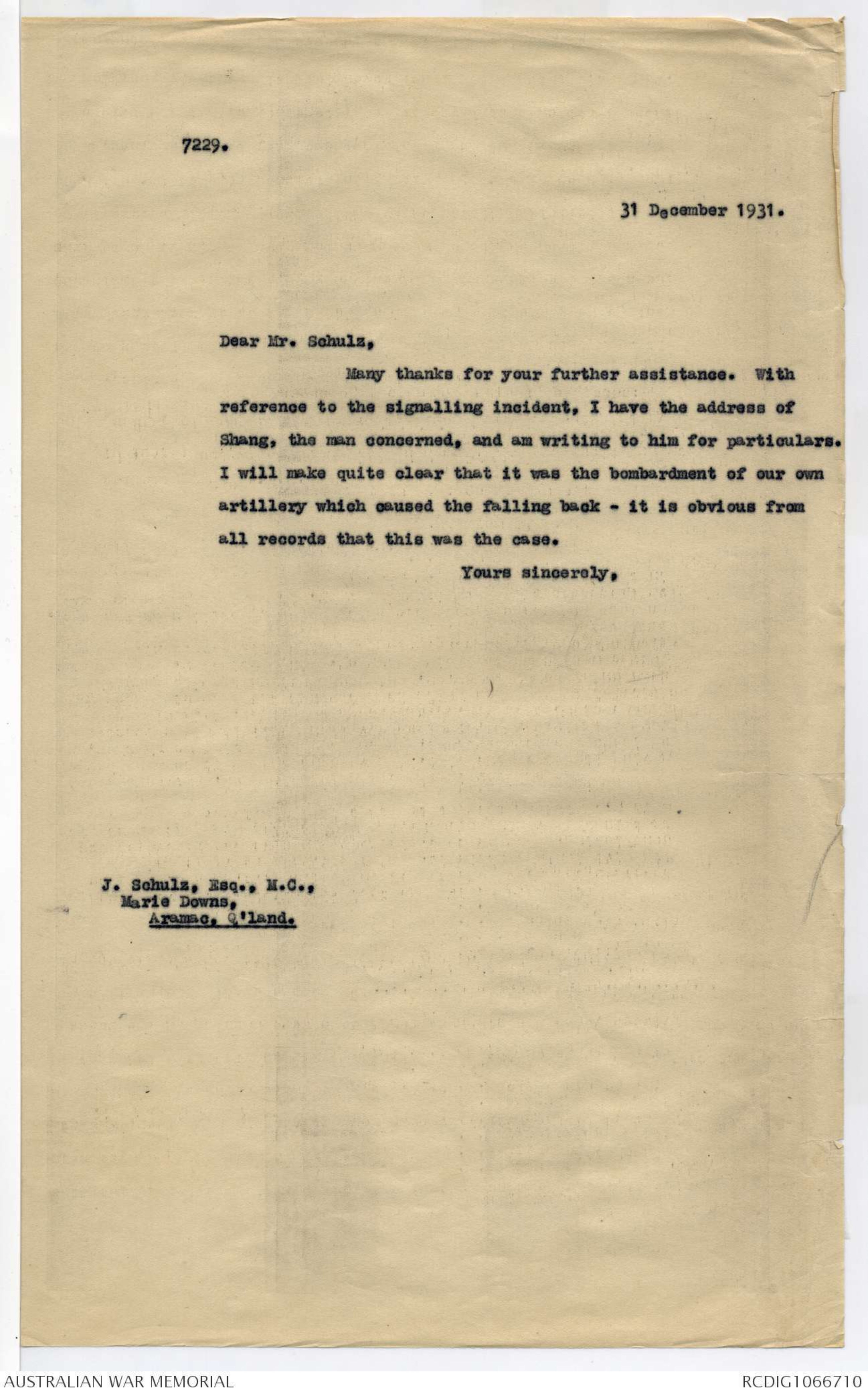
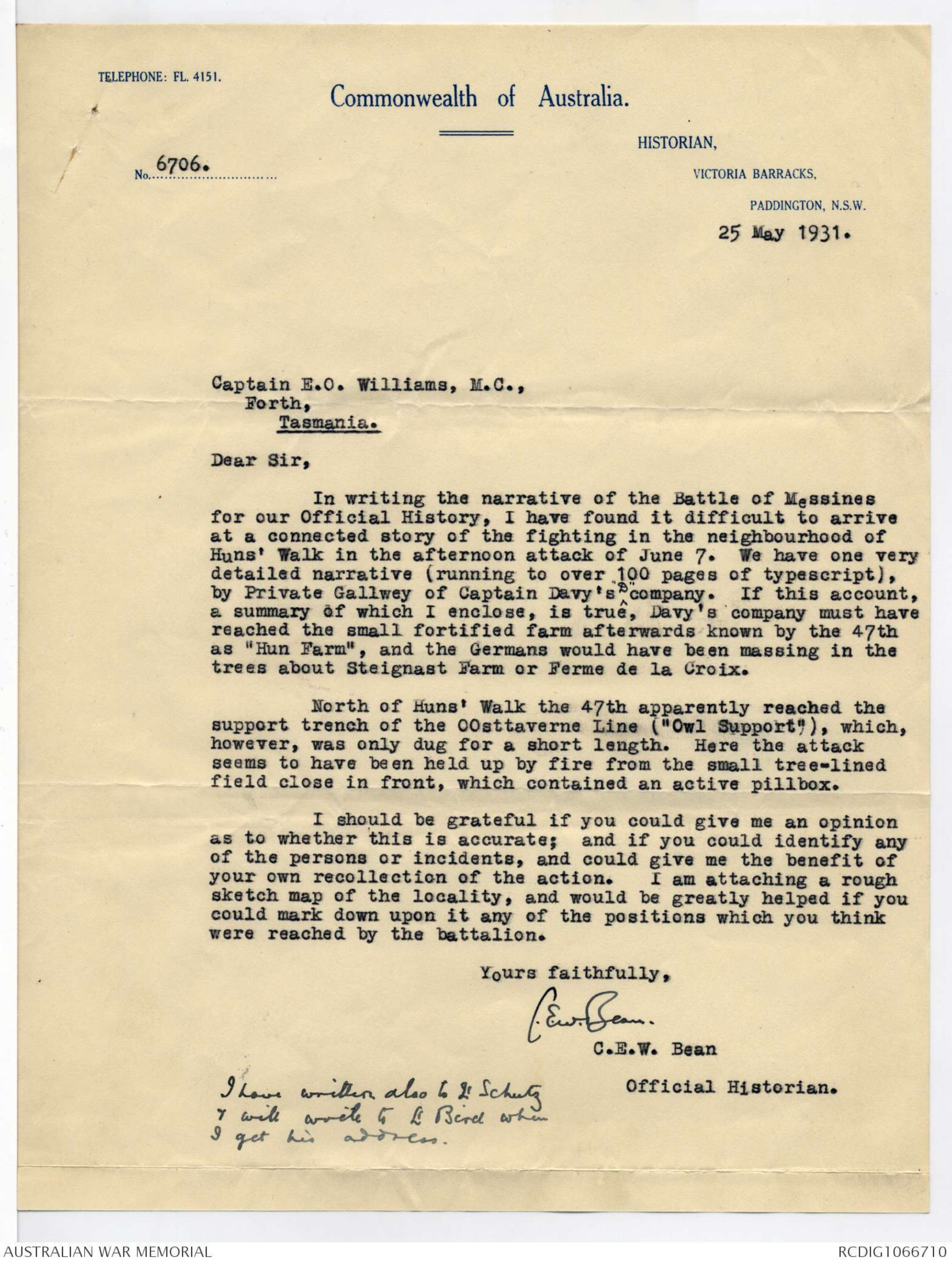
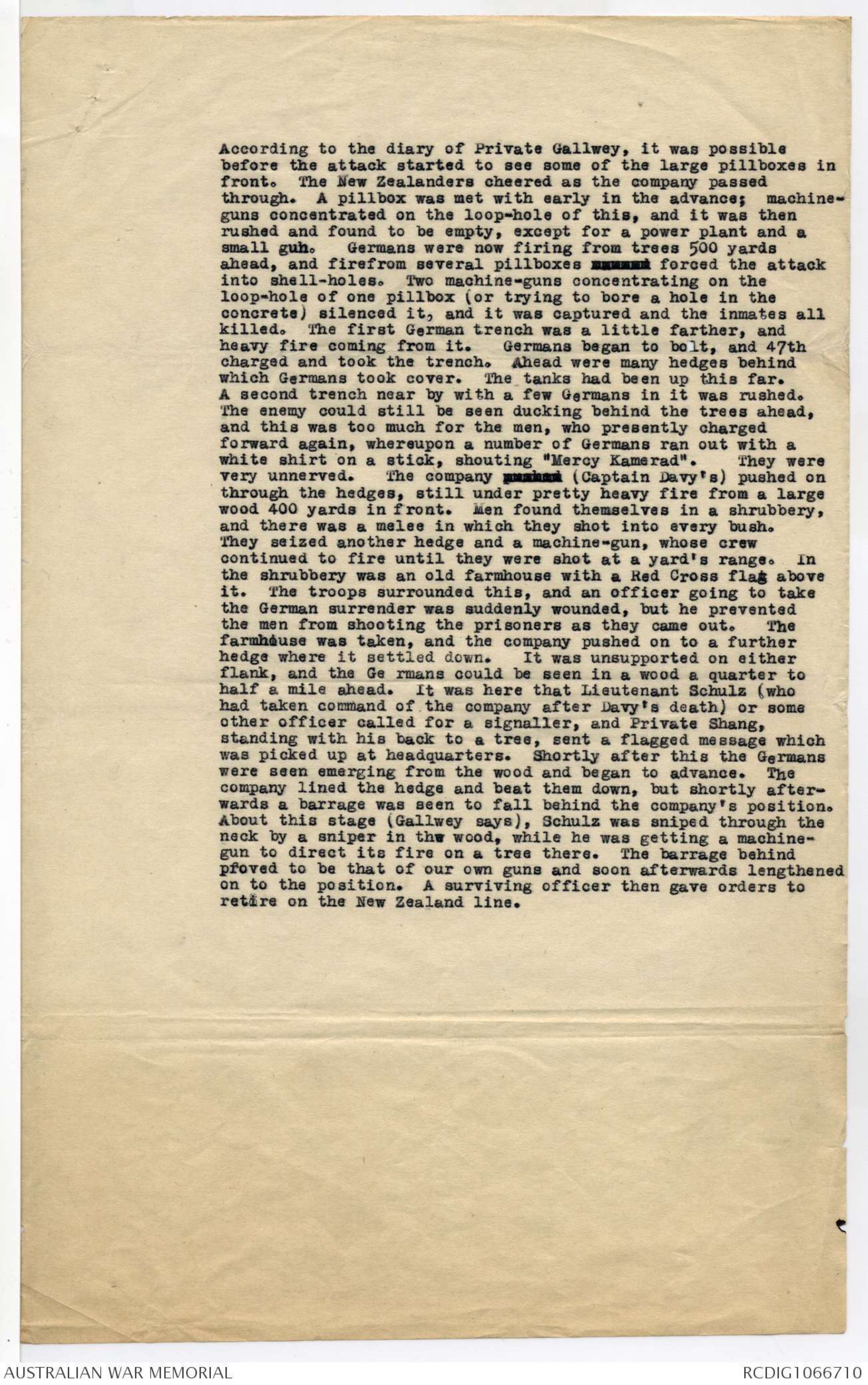
6710. [*H.N. Messines*]
1 June 1931.
J. Schulz, Esq., M.C.,
"Marie Downs",
Aramac, Q'land.
Dear Mr. Schulz,
I have written to Captain Williams, and will write
to Lieutenant Bird as soon as I can ascertain his address. In
the meantime I will be grateful if you could supplement the
valuable account that you have given me by saying -
(i) Whether you actually remember seeing the building in
enclosure on the 47th's right, afterwards known as Hun
House, and whether, so far as you saw, it was ever
captured.
(ii) I think that the officer, mentioned in my narrative,
who directed two machine-guns on to the loophole of the
pillbox, must have been yourself. I should be obliged
if you would confirm this.
(iii) One account speaks of a young officer, wearing a
bombing breastplate, who was mortally wounded by the
explosion of one of his own bombs through a bullet. It
was said that, knowing himself dying, he quietly dictated
his directions and gave notes of the man whom he wished
to recommend. Do you know who this was?
Yours faithfully,
C.E.W. Bean,
Official Historian.
Marie Downs,
Aramac.
8th June 1931. Q'land
Dr C.E.W. Bean
Official Historian.
Victoria Barracks.
Paddington. N.S.W.
Dear Sir, Re. 6710.
I am replying
to your letter of 1st instant.
My answers to your queries would
be as follow.
(1) I remember seeing the building on
the 47th's right, or what appeared to me
to be a small farm house. I can't
swear that our men actually occupied
it. but I believe that it was
abandoned by the enemy when we
took up a position to the left of it,
I remember a German (I think he
was wounded) surrendering to us
about an hour after our attack;
he came from the building. From this
incident it seems reasonable to
conclude that he had been left to
his fate by his comrades; perhaps they
were killed in the attack; but it is quite
2
possible that they had previously surrendered
when we attacked. I feel sure that
Lieut. D. Bird M.C. 47th can give you
reliable information on this point. i.e.
whether the farm I refer to was known
afterwards as "Hun House."
I last saw Bird on the staff on
The Brisbane Courier
(II) Yes. it was myself.
(III) Lt. Smith? J. E. of D. Coy, 47th wore a body
shield (flexible breast plate) he was wounded
in the hip or thigh by a bullet which
hit a boux Mills grenade which he carried
in his the side pocket of his tunic; he
quicky recovered ^in England and later returned
to his Btn. (I don't think a ^(Mills) grenade
would explode if it were hit by a
bullet.) I fancy the story about Smith's
dying depositions is all romance
certainly the dying is because Smith
was with the 47th at Dernancourt near
Albert in the March - April 1918 fighting.
Yours faithfully
John Schulz
6739.
15 June 1931.
J. Schulz, Esq.. M.C.,
"Marie Downs,"
Aramac, Q'land.
Dear Mr. Schulz,
I have to thank you for your reply to my further
queries. It will be very helpful.
The great trouble that I have in dealing with
accounts like Gallwey’s is that while I am led to suspect that
some details are inaccurate, and probably due to hearsay, I
find that on other points, where I can check them, they are
surprisingly accurate and honest. It is evident that the
diarist has made an honest effort to tell the exact story, but
has been unable to distinguish between the true and the false
in what he hears from others.
We have now received Bird's address, and a letter
is going to him today. I am very grateful for your help, and
may have to call upon you again if I cannot sufficiently clear
up the narrative.
Yours sincerely,
C.E.W. Bean
7140.
26 November 1931.
J. Schulz, Esq., M.C.,
Marie Downs,
Aramac, Q'land.
Dear Mr. Schulz,
With a great deal of labour I have pieced
together the various accounts of the 4th Division's attack at
Messines, and I am wondering if you would be so good as to read
through it and let me have your views as to its accuracy, so
far as it concerns the events of which you have personal
knowledge. I am much indebted to you for your previous help,
which has been of material assistance. Captain Williams also
assisted me, but I have been unable to get touch with Lieutenant
Bird, although I think my letters must have reached him.
I am forwarding under separate cover the sections
dealing with the operation in which you took part.
Yours faithfully,
C.E.W. Bean.
Marie Downs
Aramac. Q.
18th Dec 1931.
Dr. C.E.W. Bean
Official Historian,
Victoria Barracks,
Paddington. N.S.W.
Dear Sir
I received your letter of 26th Nov
some days ago. I believe it was delayed
by the wet roads at this end.
I have carefully perused the account of
the 4th Divisions' attack at Messines,
which is a very faithful representation
of the action. Except for one or two
statements, which are probably of minor
importance the whole narrative is
remarkably accurate in so far as the
facts are known to me.
On page 665. my name is mentioned in
connection with a signaller calling for
artillery support: - this statement must be
a fabrication - because, from the / advanced
position which I used as a company H.Q.
it was impossible to use flags - visibility was
as bad as in a Broken Hill dust storm,
besides the woodsand hedges were an
additional screen: On page 666. It should
Marie Downs
Aramac. Q.
2
Dr. C. E. W. Bean.
Official Historian.
be stated that the barrage from our guns was
concentrated on our advanced position.
Why it was directed onto our position instead
of beyond us can surely be accounted
for by our G.O.C. Artillery. This barrage
which rained down on us had possibly
more to do with ^some of our troops falling
back, than any half hearted German
counter attack; could have done had.
Considering, the difficulty of your task in
writing a detailed and descriptive account
of the fighting - the wonder to me is that you
have avoided so much of the vivid and
fictitious which creep into the accounts of
imaginative writers.
It has been a pleasure to assist you
if I have been able to do so in the slightest
way, and I thank you for your remarks
in your letter.
Yours faithfully,
J Schulz
P.S.I am returning the M.S. to under Separate Cover
JS
7229.
31 December 1931.
Dear Mr. Schulz,
Many thanks for your further assistance. With
reference to the signalling incident, I have the address of
Shang, the man concerned, and am writing to him for particulars.
I will make quite clear that it was the bombardment of our own
artillery which caused the falling back - it is obvious from
all records that this was the case.
Yours sincerely,
J. Schulz, Esq.. M.C.,
Marie Downs,
Aramac, Q'land
TELEPHONE. FL. 4151
Commonwealth of Australia.
No.....6706.
HISTORIAN,
VICTORIA BARRACKS,
PADDINGTON, N.S.W.
25 May 1931.
Captain E.O. Williams, M.C.,
Forth,
Tasmania.
Dear Sir,
In writing the narrative of the Battle of Messines
for our Official History, I have found it difficult to arrive
at a connected story of the fighting in the neighbourhood of
Huns’ Walk in the afternoon attack of June 7. We have one very
detailed narrative (running to over 100 pages of typescript),
by Private Gallwey of Captain Davy's ^"D" company. If this account,
a summary of which I enclose, is true, Davy's company must have
reached the small fortified farm afterwards known by the 47th
as "Hun Farm", and the Germans would have been massing in the
trees about Steignast Farm or Ferme de la Croix.
North of Huns’ Walk the 47th apparently reached the
support trench of the OOsttaverne Line ("Owl Support"), which,
however, was only dug for a short length. Here the attack
seems to have been held up by fire from the small tree-lined
field close in front, which contained an active pillbox.
I should be grateful if you could give me an opinion
as to whether this is accurate; and if you could identify any
of the persons or incidents, and could give me the benefit of
your own recollection of the action. I am attaching a rough
sketch map of the locality, and would be greatly helped if you
could mark down upon it any of the positions which you think
were reached by the battalion.
Yours faithfully,
C.E.W. Bean
Official Historian.
I have written also to L. Schutz
I will write to Lt Bird when
I get his address.
According to the diary of Private Gallwey, it was possible
before the attack started to see some of the large pillboxes in
front. The New Zealanders cheered as the company passed
through. A pillbox was met with early in the advance; machine-guns
concentrated on the loop-hole of this, and it was then
rushed and found to be empty, except for a power plant and a
small gun. Germans were now firing from trees 500 yards
ahead, and firefrom several pillboxes xxxxxx forced the attack
into shell-holes. Two machine-guns concentrating on the
loop-hole of one pillbox (or trying to bore a hole in the
concrete) silenced it, and it was captured and the inmates all
killed. The first German trench was a little farther, and
heavy fire coming from it. Germans began to bolt, and 47th
charged and took the trench. Ahead were many hedges behind
which Germans took cover. The tanks had been up this far.
A second trench near by with a few Germans in it was rushed.
The enemy could still be seen ducking behind the trees ahead,
and this was too much for the men, who presently charged
forward again, whereupon a number of Germans ran out with a
white shirt on a stick, shouting "Mercy Kamerad" They were
very unnerved. The company pushed (Captain Davy's) pushed on
through the hedges, still under pretty heavy fire from a large
wood 400 yards in front. Men found themselves in a shrubbery,
and there was a melee in which they shot into every bush.
They seized another hedge and a machine-gun, whose crew
continued to fire until they were shot at a yard's range. In
the shrubbery was an old farmhouse with a Red Cross flag above
it. The troops surrounded this, and an officer going to take
the German surrender was suddenly wounded, but he prevented
the men from shooting the prisoners as they came out. The
farmhouse was taken, and the company pushed on to a further
hedge where it settled down. It was unsupported on either
flank, and the Germans could be seen in a wood a quarter to
half a mile ahead. It was here that Lieutenant Schulz (who
had taken command of the company after Davy's death) or some
other officer called for a signaller, and Private Shang,
standing with his back to a tree, sent a flagged message which
was picked up at headquarters. Shortly after this the Germans
were seen emerging from the wood and began to advance. The
company lined the hedge and beat them down, but shortly afterwards
a barrage was seen to fall behind the company's position.
About this stage (Gallwey says), Schulz was sniped through the
neck by a sniper in the wood, while he was getting a machine-gun
to direct its fire on a tree there. The barrage behind
proved to be that of our own guns and soon afterwards lengthened
on to the position. A surviving officer then gave orders to
retire on the New Zealand Line.
 Maralyn K
Maralyn KThis transcription item is now locked to you for editing. To release the lock either Save your changes or Cancel.
This lock will be automatically released after 60 minutes of inactivity.